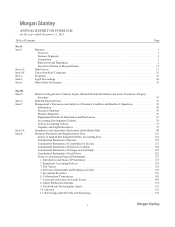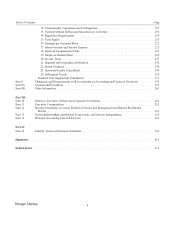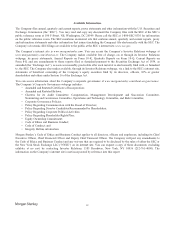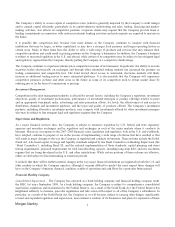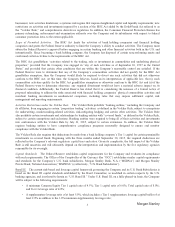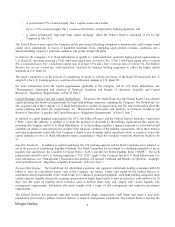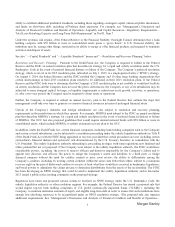Morgan Stanley 2015 Annual Report Download - page 12
Download and view the complete annual report
Please find page 12 of the 2015 Morgan Stanley annual report below. You can navigate through the pages in the report by either clicking on the pages listed below, or by using the keyword search tool below to find specific information within the annual report.
Liquidity and Capital Resources—Regulatory Requirements—Total Loss-Absorbing Capacity and Long-Term Debt
Requirements” in Part II, Item 7.) In addition, on November 12, 2015, in order to facilitate an SPOE resolution strategy, the
Company and certain of its subsidiaries, together with certain other G-SIBs, agreed to adhere to the International Swaps and
Derivatives Association (“ISDA”) 2015 Universal Resolution Stay Protocol (the “Protocol”), which applies to over-the-
counter (“OTC”) derivative transactions entered into among the adhering parties under ISDA Master Agreements and
securities financing transactions governed by specified securities financing transaction agreements. The Protocol overrides
certain cross-default rights and certain other default rights related to the entry of an adhering party or certain of its affiliates
into certain resolution proceedings. The Federal Reserve is expected to promulgate regulations implementing and possibly
expanding portions of, and the parties subject to, the Protocol.
U.S. Bank Subsidiaries.
U.S. Banking Institutions. MSBNA, primarily a wholesale commercial bank, offers commercial lending and certain retail
securities-based lending services in addition to deposit products. It also conducts certain foreign exchange activities.
MSPBNA offers certain mortgage and other secured lending products, including retail securities-based lending products,
primarily for customers of its affiliate retail broker-dealer, Morgan Stanley Smith Barney LLC (“MSSB LLC”). MSPBNA
also offers certain deposit products, as well as prime brokerage custody services.
Both MSBNA and MSPBNA are FDIC-insured national banks subject to supervision, regulation and examination by the
OCC. They are both subject to the OCC’s risk governance guidelines, which establish heightened standards for a large
national bank’s risk governance framework and the oversight of that framework by the bank’s board of directors.
Prompt Corrective Action. The Federal Deposit Insurance Corporation Improvement Act of 1991 provides a framework for
regulation of depository institutions and their affiliates, including parent holding companies, by their federal banking
regulators. Among other things, it requires the relevant federal banking regulator to take “prompt corrective action” (“PCA”)
with respect to a depository institution if that institution does not meet certain capital adequacy standards. Current PCA
regulations generally apply only to insured banks and thrifts such as MSBNA or MSPBNA and not to their parent holding
companies. The Federal Reserve is, however, authorized to take appropriate action at the holding company level, subject to
certain limitations. Under the systemic risk regime, as described above, the Company also would become subject to an early
remediation protocol in the event of financial distress. In addition, bank holding companies, such as the Company, are
required to serve as a source of strength to their U.S. bank subsidiaries and commit resources to support these subsidiaries in
the event such subsidiaries are in financial distress.
Transactions with Affiliates. The Company’s U.S. Bank Subsidiaries are subject to Sections 23A and 23B of the Federal
Reserve Act, which impose restrictions on “covered transactions” with any affiliates. Covered transactions include any
extension of credit to, purchase of assets from, and certain other transactions by insured banks with an affiliate. These
restrictions limit the total amount of credit exposure that the Company’s U.S. Bank Subsidiaries may have to any one affiliate
and to all affiliates. Other provisions set collateral requirements and require all such transactions to be made on market terms.
Derivatives, securities borrowing and securities lending transactions between the Company’s U.S. Bank Subsidiaries and
their affiliates are subject to these restrictions. The Federal Reserve has indicated that it will propose a rulemaking to
implement these more recent restrictions.
In addition, the Volcker Rule generally prohibits covered transactions between (i) the Company or any of its affiliates and
(ii) covered funds for which the Company or any of its affiliates serves as the investment manager, investment adviser,
commodity trading advisor or sponsor or other covered funds organized and offered by the Company or any of its affiliates
pursuant to specific exemptions in the Volcker Rule.
FDIC Regulation. An FDIC-insured depository institution is generally liable for any loss incurred or expected to be
incurred by the FDIC in connection with the failure of an insured depository institution under common control by the same
bank holding company. As commonly controlled FDIC-insured depository institutions, each of MSBNA and MSPBNA could
be responsible for any loss to the FDIC from the failure of the other. In addition, both institutions are exposed to changes in
the cost of FDIC insurance. Under the Dodd-Frank Act, some of the restoration of the FDIC’s reserve fund must be paid for
6



